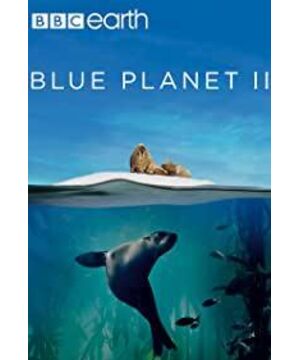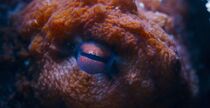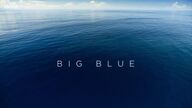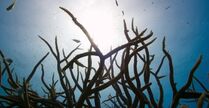Open your mouth wide
Open your mouth
The universal sigh
The sigh of all things
And the ocean blooms
The blooming ocean
It's what keeps me alive
Let me live in this precious world
When the magnificent theme song symphony sounded, a group of spinning dolphins rode the waves, 91-year-old David Attenborough stood on the bow of the ship, still wearing the light blue short-sleeved T-shirt, and the sea breeze disturbed him. s hair.
He said: "Just under my feet, there are creatures beyond our imagination cruising. The revolutionary update of technology has allowed us to enter a whole new world and photograph some animal behaviors that could not be photographed more than ten years ago. At the same time, we are also aware that the changes in the ocean today are unique in human history...this is Blue Planet 2."
Looking through the autumn water in my lifetime, when I meet on a narrow road, the music and narration of the pictures make the corners of my eyes moist. If you want to say how you feel after watching the first episode, I can't think of a metaphor, I can only say that the whole person was shocked like a fool.
"During the five-year shooting process, the film crew went through 125 expeditions, visited 39 countries, and traveled almost all continents and oceans around the world. The film crew’s underwater shooting time reached more than 6000 hours. From the familiar coast to the dark depths of the ocean, there are so many beautiful sceneries." -Executive Producer James Honeyborne (James Honeyborne)
The first episode, the same ocean, tells eight stories.
In the Red Sea, a group of unique bottlenose dolphins rub their bodies against a specific coral, and this coral may have some anti-inflammatory properties to make the dolphins feel comfortable. A small dolphin also learned "coral massage" with his parents. At the same time, it also inspired us to have drugs that can treat diseases in the ocean.
Next, I talked about the daily life of a hogtooth fish: turning over the coral pile, blowing the fine sand, and looking for its beloved food-a kind of clam. Then it always swims back to a specific "kitchen" surrounded by a kind of hard coral, so the clam is picked up and slammed to a specific location on the coral reef, once or twice...until it is broken by the clam shell. Enjoy the delicious food.
This challenges the human imagination of fish IQ. In order to shoot it, it is said that the film crew spent two years and finally edited it into three minutes.
The sea in Seychelles was calm, and suddenly a rare trevally jumped out to prey on the black tern, and then more black terns were preyed on, thank goodness, finally, a little tern was urged by his parents to escape the rare trevally. Big mouth.
In the beginning, the story of fish-eating bird was only told by a fisherman. Without any photographic evidence, the film crew director felt that this was a risk worth taking in his 30-year career, so the four film crew took 800 kilograms of filming. The device, including an anti-shake camera, came to a remote atoll in Seychelles and filmed from the ship. In the end, it took several weeks to finally get the shot that I saw.
Manta rays gathered in large numbers in the Sea of Cortez near Mexico, flapping their wings, and noctilucent algae gleamed under the black water. This scene is almost like magic. When the manta rays circled around the camera for food, they left a string of bright lights behind them.
All this thanks to the ultra-high-definition low-light camera. The photographer took this picture in almost total darkness.
In the waters of New Zealand, hundreds of bottlenose dolphins tightly flock to about 150 pseudo-killer whales. They seem to be able to understand each other's language.
They work together to form a powerful predator army, and scientists believe they are old friends.
When the female golden headfish living in the Sea of Japan reaches a certain age and body size, it will become male in a very short time.
Before, I was still living with the male double-stay, and suddenly he challenged and defeated his ex-husband, and tried to "incorporate the female fish protected by these males into the harem."
In the fjords of northern Norway, killer whales drive herring schools to the shallow waters of the coast, and then they stun the herring with a whirling kick so that they can eat the herring smoothly.
When the silver light appeared on the sea surface, a large group of hungry humpback whales came from the deep sea, opened their mouths and feasted with the killer whales. The scene where the humpback whale swims is like a dream.
Because of global warming, walruses living in the Arctic are driven into the sea by polar bears. In the sea, there is less and less chunks of sea ice.
The walrus mother had to hold the baby walrus to look for sea ice where she could settle, and bumped into the wall everywhere.
Faced with the walrus that finally found a place to shelter, Attenborough’s lines wrote: Mom finally found a place to shelter, she was able to stay with her baby and enjoy the love between mother and child, but no one knew their future What will happen.
Yes, in today's ocean, the sea ice at the poles has melted, the sea level has risen, corals have bleached, and garbage is all over the ocean. No one knows what her future will be.
In order to take these shots, photographers photographed dolphins in strong winds and waves, and the BBC also offered black technology.
"Looking back, when we filmed "Blue Planet", we needed to take a helicopter, using 16mm film. Now, we can set up ultra-high-definition drones wherever permission is granted, and the shooting method has undergone a fundamental change. . This kind of disruptive shooting technology and the current best broadcast technology provided by Tencent Video allows us to overlook various ocean events while adding details and insightful events. With revolutionary new technology, we can Enter the new world and photograph the behavior of these marine animals in a new way that was unattainable more than a decade ago."-Executive Producer James Honeyborne (James Honeyborne)
The use of ultra-high-definition and high-sensitivity cameras has recorded many unprecedented animal behaviors; when fish and dolphins are preying on high-speed attacks in the ocean, the crew uses a towed camera to film their behavior; a suction cup camera can serve the audience Provide a unique perspective of riding on large marine animals, like whale sharks and killer whales; when shooting coral reefs, in order to create an immersive feeling for the audience, the film crew developed a special detection camera. Go deep into the corners and crevices of the coral reef and explore the hidden animals.
After "Earth Pulse 2", Hans Zimmer continued to soundtrack for "Blue Planet 2," and the rock band Radiohead's singing made the whole film even more shocking.
This series has a total of seven episodes. The second episode is Deep Sea. Let us look forward to it, "Open your mouth wide" and suck this film (Tencent Video will start from today and update one episode every Monday).
The health of our oceans is under threat.
The health of our oceans is threatened
They're changing at a faster rate than ever before in human history.
This is changing faster than ever in human history.
--David Attenborough
——David Attenborough
Watched the whole movie ahead of time, and see the comments for the last episode:
The last episode of "Blue Planet 2": Seeing beauty and sorrow
View more about Blue Planet II reviews









